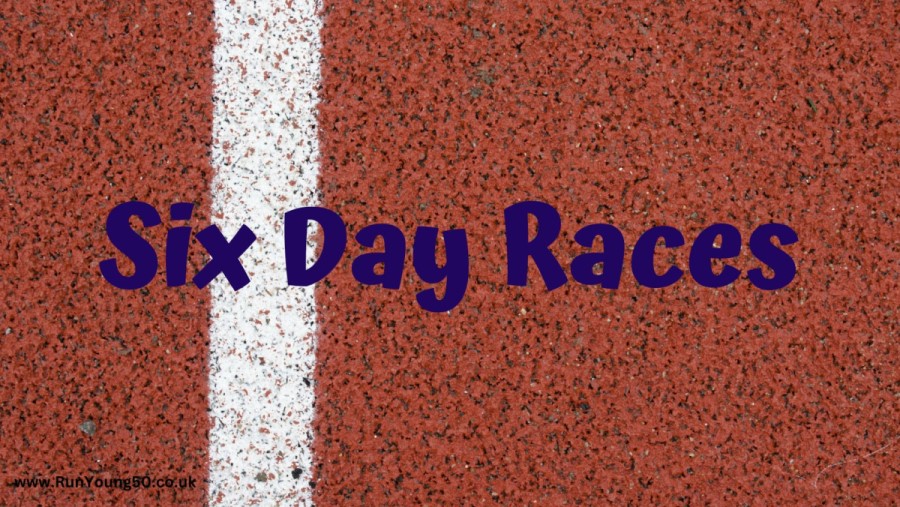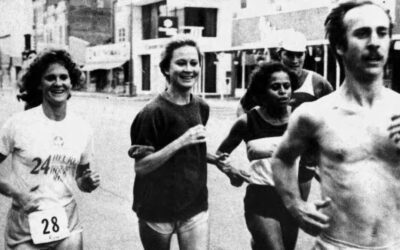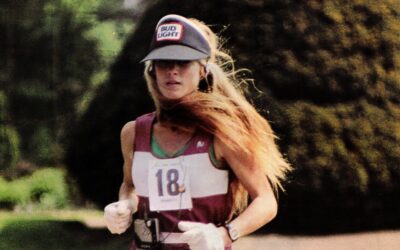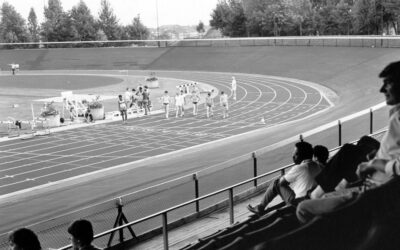The history of women’s six day ultra races has been overshadowed by the focus on the men’s record. The impetus for writing a series of posts about the women’s six day record came from interviewing Eleanor Robinson and Lorna Richey Michael who both competed in the New York Road Runners Six Day Track Race in 1984. I realised that 1984 was a stellar year in the history of the women’s event. The record changed hands five times and women drove the distance up by 91 miles in just 8 months. There hasn’t been a year like it before or since.
Six day ultras began with Victorian-era pedestrianism. Women competed in both individual events and races against other women in the 1870s and 1880s. The six day format was revived in the USA in 1980. The following year, Marcy Schwam became the first woman to compete in a six day race since the revival, setting the “modern era” record. This post sets out the progression of that record since 1981.
Women’s six day world record progression
June 1981 – Marcy Schwam (USA) – 384 miles/617.988km – Pennsauken, New Jersey, USA
August 1982 – Ros Paul (UK) – 407 miles 741 yards/655.689km – Nottingham, UK
August 1983 – Eleanor Adams (UK) – 409 miles 1178 yards/659.298km – Nottingham, UK
May 1984 – Christine Barrett (UK) – 421 miles 1320 yards/678.741km – Stoke-on-Trent, UK
June 1984 – Mary Hanudel (USA) – 423 miles/680.753km – Pennsauken, New Jersey, UK
July 1984 – Eleanor Adams (2) – 462 miles, 278 yards/743.771km – New York, UK
October 1984 – Edith Couhé (France) – 472 miles, 1300 yards/760.800km – La Rochelle, France
December 1984 – Eleanor Adams (3) – 500miles 1452 yards/806.000km – Colac, Australia
March 1986 – Eleanor Adams (4) – 502 miles 994 yards/808.800km – Colac, Australia
November 1987- Eleanor Adams (5) – 521 miles 362 yards/838.800km – Colac, Australia
November 1989 – Eleanor Adams (6) – 538 miles 1063 yards/866.800km – Colac, Australia
November 1990 – Sandra Barwick (New Zealand) – 549 miles, 110 yards/883.631km – Campbelltown, Australia
March 2024 – Camille Herron (USA) – 560.3 miles/901.768km – La Quinta, California
Notes on world record progression
The world record progression shows that Eleanor Adams (now Robinson) was the preeminent ultrarunner for the six day event. Adams set the record six times from 1983 to 1989. She remains the only woman to have held the record more than once. During this time the record distance increased by over 128 miles. Her 1989 performance still stands as the v35 world record and the British record. It was her last six day race. Sandra Barwick finished just 6km behind Adams and took the record the following year.
Camille Herron broke Barwick’s record at the “FURTHER” women-only six day race in La Quinta, California. The event was a joint initiative between Herron and her sponsor, athletic brand Lululemon. Herron also holds the world records for 100 miles, 24 hours and 48 hours (IAU records update 30th May 2024). When the International Association of Ultrarunners (IAU) signalled its intention to eliminate the 1000 km, 1000 mile and 6-day races as official IAU races in 2021, Herron was one of the athletes who objected to the decision. The IAU reconsidered its decision on the six day event and reinstated it.
Sandra Barwick’s world record, set in 1990, was also the v40 record. Both Adams and Barwick ran their longest distances in their early forties. Camille Herron is 42 and now has the v40 record.
Herron joins an elite group of women who have exceeded 800km/500miles. The others are Eleanor Adams, Sandra Barwick and Catherine (Dipali) Cunningham of Australia. Cunningham has done this three times at the Sri Chinmoy 6 Day Road Race in New York, first in 1998 and then again in 2001 and 2009. Her 2009 performance, 512 miles 1759 yards/825.593km, is the current Australian record.
Prior to Herron’s performance, the best performance so far this decade was by Annie Paringaux (v55) of France. She covered 492miles 247 yards/792.024km at Policoro in Italy in March 2022.
Six day racing for women today
In 2008, Andy Milroy wrote:
The six day event continues to be a focus for multi-day runners all over the world, but there are relatively few such races, due to the cost and commitment needed to organise such a prolonged race. Consequently the number of six day runners is not large. The race continues to have a unique place in the sport of Ultrarunning, and for many remains a fascinating and formidable challenge.
According to the Deutsche Ultramarathon Vereinigung (DUV) website, more than a dozen races of six days or longer were held in 2023 in the USA, seven European countries, and Australia. 131 women competed. This suggests that the six day format is still popular despite the challenges of hosting such long events.
Ten invited athletes participated in the Further race. None had completed a six day race before. Data from the race will be used in sports science research. Lululemon is collaborating with the Canadian Sport Institute Pacific to research fatigue resistance, and the physiological and biomechanical effects of ultrarunning on women.
It is to be hoped that the “Further” race created by Camille Herron and Lululemon will create new interest in women’s six day races and reach different audiences, encouraging more women to participate.
Sources
The History of the Six Day Race, Andy Milroy, 16th October 2008, Planetultramarathon
International Association of Ultrarunners – records
(According to the IAU records updated on 30th May 2024, Camille Herron holds the 24 Hour record. Miho Nakata broke Herron’s record at the IAU World Championships in December 2023, but this performance has not been ratified.)
All-time performances, Deutsche Ultramarathon Vereinigung (DUV)
Records, Australian Ultra Runners Association (AURA)
“lululemon’s ‘First-of-its-kind’ women’s ultramarathon”, Lululemon press release, 5th March 2024
There may be some small discrepancies in the distances given due to conversion between miles and kilometres. DUV and IAU both record in kilometres and I have converted some distances to miles. Early races were reported in the UK and USA in miles.




At one time the speedy & versatile Eleanor “owned” Sandy, but as Sandy specialized in going ever further, she put the 6-day and 1000-mile records comfortably out of reach. Respect to all; Camille seems to have both more speed and more stamina than either, but it don’t mean a thing till the bell lap goes Ring!
Hi Jesse, thank you for commenting. Sandy was just behind Eleanor in the 1989 Colac race so perhaps that was the turning point. One factor was that Eleanor gave birth to her fourth child in 1991 and i think that contributed to her focusing on shorter distances. Let’s see what Camille can achieve – it’s exciting to watch. Katie
Great read , thank you
Thank you very much Sandy. I am planning to write posts about Edith Couhe’s record and your record too. Katie
Sandy was sponsored by Kiwifruit from New Zealand when I met her at the 1000-mile WC in ’88. I was too poor then to buy them at the store; the free samples might as well be manna from heaven when you’re burning 10,000 calories a day!
Thank you for commenting Jesse. That’s an interesting detail. I haven’t started researching Sandra Barwick yet but do intend to write a post about her world record too. Katie
In ’88 Sri Chinmoy didn’t have a permit for showers or substantial outbuildings, they were building the shelters by hand the day before the start. Sandy & her crew used to microwave wet hand towels in the camp kitchen to freshen up! No crew, so I went 600 miles without bathing, though it did RAIN several times.
Hi Jesse, I can’t imagine managing such a long race without crew. It must have been difficult. Did other runners’ crews help you out?\
Katie
It was definitely a team effort! The organizers might have struggled with onsite showers (better permits by the next race) but laundry, food, and medical care were provided. Crews & sponsors & friends of friends & locals went the extra mile, as it were. Besides Sandy’s kiwifruit, Kouros offered baklava, and local ultrarunners brought the famous New York pizza. A local firefighter used to bring me premium ice cream pints: we were “adopted” one by one like lost children!
It sounds like quite an experience!
Also there, finishing the 700-Mile (her greatest race), was 58-year-old amateur Ilona (Sulochana) Kallai. She was a Hungarian native, had escaped to the West in the old Iron Curtain days. Finishers were honored with a presentation and their national anthem was played. She hadn’t been home in many years. I will never forget that tiny woman: white tracksuit, holding a trophy, laurel wreath…and tears streaming down her face as the anthem played.